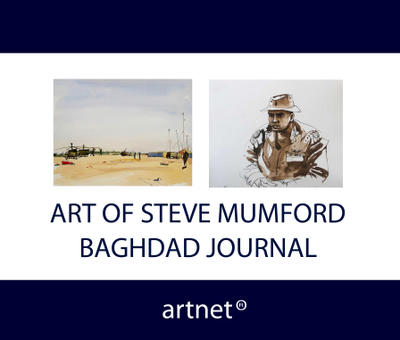Steve Mumford - New York Artist - Observations in Iraq.

Baghdad Journal by Steve Mumford
Paper Tiger
The war has been very good to Steve Mumford.
by Jerry Saltz for the The Village Voice - Art
September 9th, 2005.
"And Steve Mumford has been very good to humanity through his art."
DC
Stephen Mumford has been showing in New York since the mid 1990s. Until recently he specialized in highly colored, semi-sensationalist, quasi-apocalyptic depictions of underwater nudes, submerged cars, and the like. Often these canvases resembled adventure posters or paintings you see on the sides of vans. They were jazzy and weird, but little else.
Around 2003 something changed. Up until two years ago, he was collaging images and depicting what he imagined, but he wasn't painting what he saw. This must have concerned Mumford because that year, during the Bush administration's relentless ramp-up to war, Mumford decided he wanted to go to Iraq to become what he calls "a war artist." After he tried unsuccessfully to obtain press credentials from several sources, the online magazine Artnet gave him the paperwork he needed and soon he was in Iraq.
There, Mumford was immediately embedded with the army's Third Infantry Division out of Fort Stewart, Georgia. He was with the troops in Basra, Baghdad, Tikrit, and Kirkuk. By his own account he was scared, thrilled, and bored. He was also incredibly productive. Equipped with a camera, brushes, and other tools, over 11 months and four visits he made hundreds of ink drawings and watercolors. Scores have been posted on Artnet as the visual component of his Baghdad Journal, his hardscrabble, to my ear monotonous and jargon-filled but undeniably thorough, 16-part, 75,000-word record of his and the troops' actions.
Not to be glib or impugn his motives, but the war has been very good to Steve Mumford. His Iraq work has been exhibited in galleries and museums across the U.S. and is on display until September 26 as part of P.S.1's "Greater New York" show. Last December, The New York Times ran a splashy feature on him. He was named "Person of the Week" by ABC News and interviewed by no less than the late Peter Jennings, who deemed him "part of a great wartime tradition."
Mumford did become a better, more observant draftsman in Iraq. He learned to work fast and in tight spaces. Nevertheless, however much his work is compared to Winslow Homer, Otto Dix, and Kathe Kollwitz, his Iraq work comes off as little more than courtroom drawing or generic illustration. Really, it's not that different from news photos you see of soldiers relaxing, Humvees smoldering, or locals milling about. He almost could have done them from home. There's little of what Susan Sontag, referring to photojournalism's relationship to war, called "the photography of conscience." There's no Goya, nothing wrenching or ravishing. Mumford obviously cares about the troops, but his drawings have an academic, bleached-out detachment. The work is attentive but not insightful, detailed but not affecting. You never get the feeling he's examined the moral ambiguity of war, the guilt, adrenaline rush, deprivation, or self-gratification of it. The pictures are proficient but impersonal.
Good "war art" now would probably be what it's always been: more than just "war art." It would stand on its own, connect up to other art, and be both universal and specific. We would be able to look at it without knowing what war this is but still see the suffering, insanity, humor, dreariness, or the harsh beauty of combat. The superb war photographer Don McCullin said he wanted his work to "break the hearts and spirits of secure people." Mumford essentially lulls the eye.
Mumford maintains he went overseas "thinking the war was a huge blunder." Now he says he's "in favor of the mission," and that he "began to understand the invasion differently after spending time with Iraqis." That's fine. There's ample evidence of his commitment and passion in the written part of the journal. Unfortunately, it's not in the visual part.
Mumford should go back to Iraq and paint and draw this passion. He should really reveal himself, show us why the mission is right. His friend, the writer Steven Vincent, went to Iraq (at the same time as Mumford) and made his pro-war position clear in his book on Iraq. Sadly, Vincent was killed there last month by kidnappers days after writing a New York Times editorial critical of the Basra police. Mumford needn't risk his life. He should just put his beliefs into his visual work. I totally disagree with his position. However, if he truly painted his conscience, Mumford could really test the system. We would see if an artist who openly believes in the war would be embraced by an art world that insists it is open-minded and tolerant of divergent opinions. Mumford is obviously filled with the rage, desire, and the need for redemption that going to war seems to require. He just needs to get this on paper.
jsaltz@villagevoice.com


<< Home